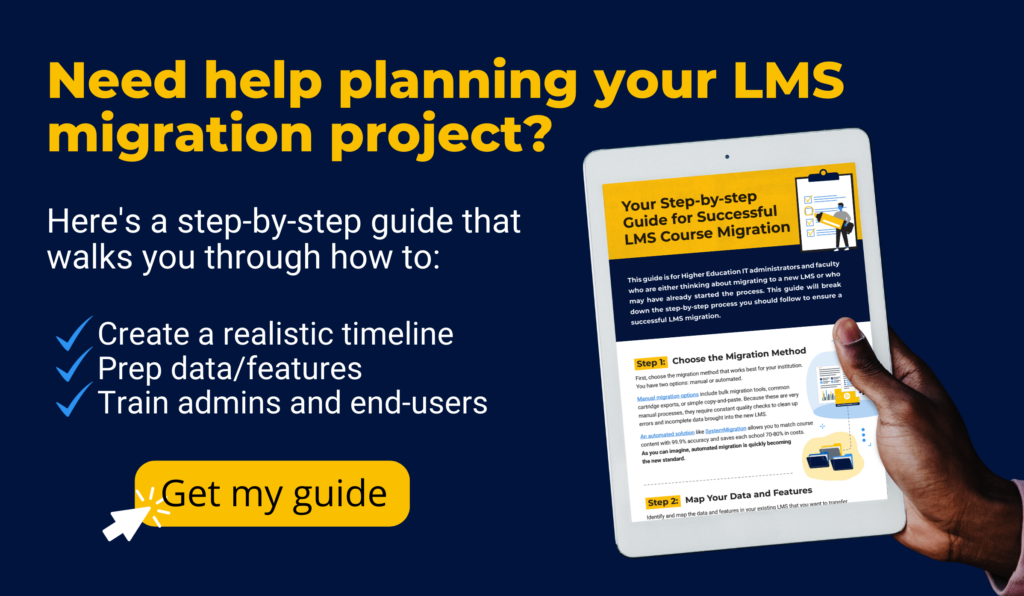How Much Does LMS Migration Actually Cost?
If you’re looking to update your online learning technology to a new Learning Management System (LMS), then you’ve likely begun to flesh out your budget. But do you know how much LMS migration actually costs?
The answer is that it depends on the method of migration that you choose. You’ll also need to look at all of the different kinds of costs associated with this change, not just the literal monetary expense.
Let’s look at everything you need to consider when budgeting and choosing your migration method.
How much does manual migration cost?
Manual migration options include:
- Bulk migration provided by your new LMS
- Common cartridge exports
- Hiring a temporary white glove service
- Overtime pay to use faculty and staff
The problem is that each one of these options involves manual copying and pasting to get the course content on your new platform.
Below are some of the costs associated with these migration options.
Monetary cost

Cost of migration
First, you need to consider the literal cost of migration.
Bulk migration from your old LMS may cost as little as $1 per course, or it may even be free. That may sound great, but keep in mind that these common cartridge exports will require a very manual process of copying and pasting content that was not captured in the transfer. Much of the content won’t be aligned properly in the new LMS, and that means you’ll need staff or instructional design hours to complete the transition.
Additional white glove services can be used to help organize and streamline bulk migrated courses, but those services can cost anywhere from $100-500 per hour, and we’ve seen that most courses take several hours at a minimum to correct.
Cost to hold onto your legacy LMS
Next, you need to consider the expense of holding onto your legacy LMS for months or even years as you manually migrate courses to your new platform. Oftentimes, institutions don’t consider that migrating manually (bulk migration) can be so lengthy and result in needing to maintain two LMS platforms – the legacy LMS and the new one.
You will be paying for two LMS’s during this time period, which could be up to hundreds of thousands of dollars in extra expenses. An automated approach can get you off of your old platform in about 90-120 days!
Pro Tip: How long do you plan to hold onto two platforms? When creating your budget, make sure to add in that expense.
Overtime hours and stress
Because these manual methods will not allow you to one-to-one match courses, faculty and staff will need to step in and manually copy and paste information.
Oftentimes, faculty will be required to do this additional work outside of their normal hours and even on weekends.
This process is also slow-moving–one course could take up to a week or more.
This is not what you hired faculty and staff to do. Many feel stressed and overworked by this additional workload.
Human mistakes
Since manual migration involves some manual cleanup by copying and pasting, it’s prone to human errors. Each course that a human touches is susceptible to mistakes such as typos or information misplacement.
Staff and student confusion
Since you will likely need to have two LMSs at one time for one or more semesters, that means that students and staff will need to go back and forth between two different platforms.
This causes stress, confusion, and–oftentimes–grading and assignment errors.
Missed deadlines
Often, institutions don’t realize how slow and labor-intensive LMS migration is.
Manual migration methods promise certain deadlines that don’t happen, or if they do transfer courses by the proposed timeline, the content is a jumbled mess that no one can understand until someone goes in manually to correct it after the fact. By this point, you’ll have missed one or more important deadlines.
Missing deadlines is alarming for stakeholders and faculty alike. Many will lose faith in the benefits of moving to a new LMS.
How much does automated LMS migration cost?
Not everything is doom and gloom about LMS migration costs.
There is a better way–one that is automated.
With an automated LMS migration solution, you can one-to-one match all course content with ease. That means no copying, pasting, or manual labor involved.
It’s as easy as choosing what courses to move over and what you’d like them to look like.
Monetary cost
With an automated solution like Scaffold LMS Migration, it generally costs anywhere from $65-99 a course for the first 1,000 transferred over and then $25-75 per additional course, depending on a number of various factors.
That’s it. That’s all you will pay to move from one platform to another.
How much LMS migration actually costs is up to you
With Scaffold LMS Migration, your migration will be complete in as little as 90-120 days, eliminating issues like missed deadlines, overtime, confusion, extra stress, human mistakes, and the big cost of holding onto two platforms for up to a year or more.
Everything is organized and easy to find in the new platform. Even features that no longer exist in the new platform, like quizzes or question pools, are transferred over with ease.
Take a look at some of our case studies to see how this new efficient method of migration is possible in such little time.
Learn more about how much LMS migration actually costs with an automated solution. Talk with one of our migration experts to discuss your institution’s needs and get a free demo to see how easy it is to transfer courses to your new platform.


